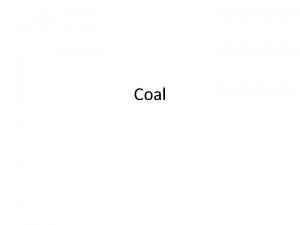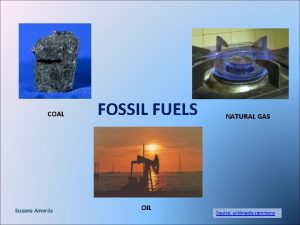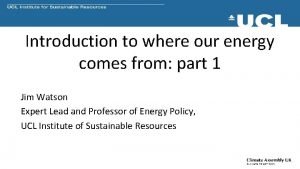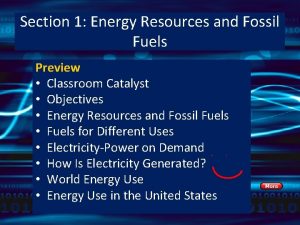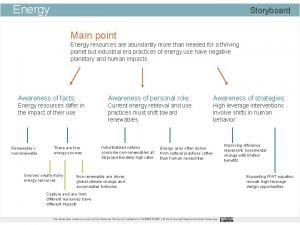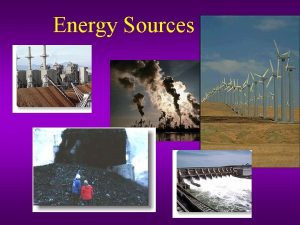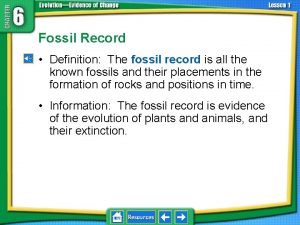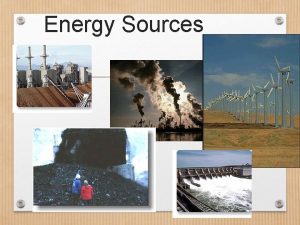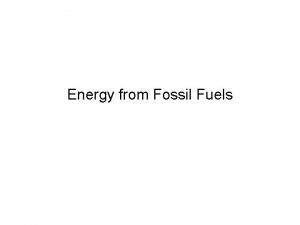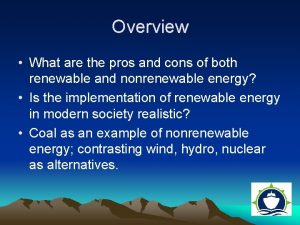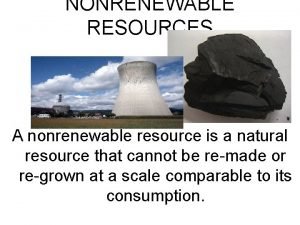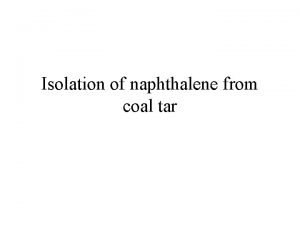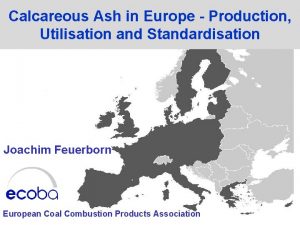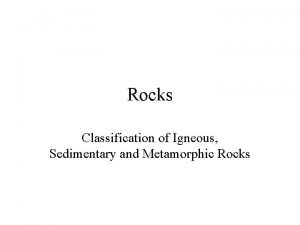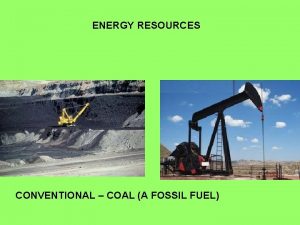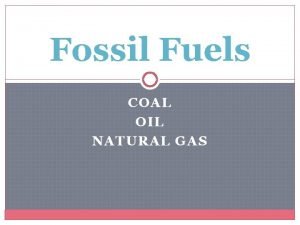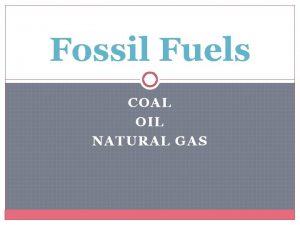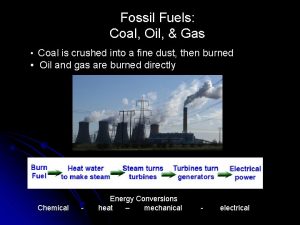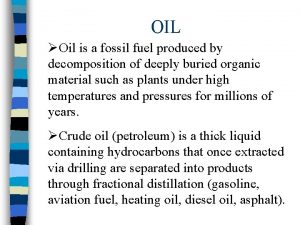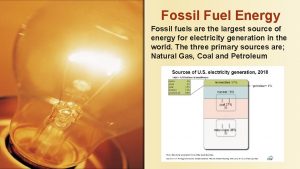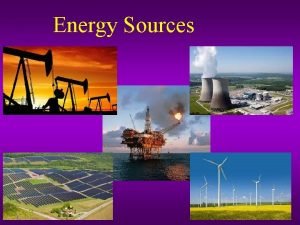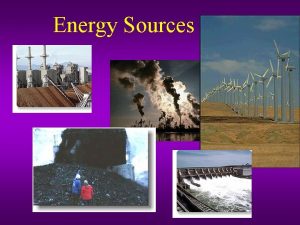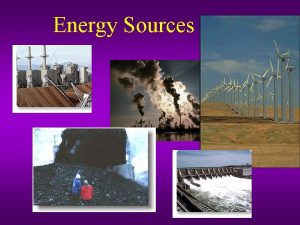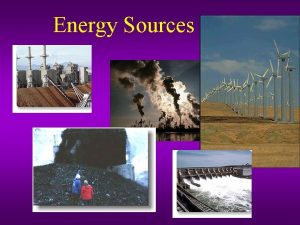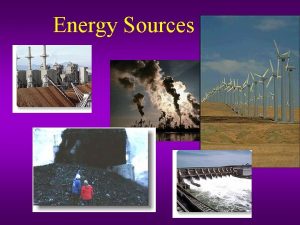Energy Resources Energy Resources Fossil Fuel Oil Coal
































- Slides: 32

Energy Resources

Energy Resources • Fossil Fuel – Oil – Coal – Natural Gas • Nuclear • Renewable

Renewable Resources • Hydroelectric • Wind • Solar • Tidal • Fuel cell • Geothermal • … …

Primary Resources • Over 99% of worldwide electric energy – Hydro – Fossil – Nuclear

Electric Energy Resources

Electricity Generated by Primary Resources (worldwide, 2010) Hydroelectric 6% Nuclear 6% Oil 35% Coal 27% Natural Gas 26%

Electricity Generated by Primary Resources (USA, 2010) 2 000 1 800 1 600 1 400 TWh 1 2000 1 000 2010 800 600 400 200 0 Coal Petroleum Natural Gas Nuclear Hydroelectric Renewable

Consumed Electric Energy (worldwide, 2010) 7 000 6 000 5 000 TWh 4 000 2000 3 000 2010 2 000 1 000 0 United States Europe 16280 Terawatt hours 16. 28*1012 k. Wh Central & South America Middle East Asia & Oceania Rest of World

Installed Capacity in 2010 1800 1600 1400 1200 GW 1000 2000 800 2010 600 400 200 0 United States Europe Central & South Middle East America Asia & Oceania Rest of World

Example • Compute the annual electrical energy consumption per capita worldwide in 2010.

Annual Electric Energy Consumption Per Capita Worldwide • World population: 6. 89 x 109 – world census for 2010 • Annual electric energy consumed per capita worldwide Total world consumption/world population = 17. 444*1012/6. 89*109 = 2. 53 MWh

Example • Exclude USA and compute the annual electrical energy consumption per capita worldwide in 2010

Annual Electric Energy Consumption Per Capita Worldwide without USA • US population in 2010 is 3. 1*108 • World population without USA: (6. 89 -0. 31)*109 =6. 58*109 • World Consumption minus USA: (17. 444 -4. 12)*1012 = 13. 324*1012 k. Wh • Energy consumed per capita worldwide without USA 13. 324*1012/6. 58*109 = 2. 025 MWh

Example • Compute the annual electric energy consumed per capita in the US in 2010.

Annual Electric Energy Consumption Per Capita in USA • US population is 3. 1*108 – US estimate for 2010 • Annual electric energy consumed per capita in the USA 4. 12*1012/3. 1*108 = 13. 29 MWh • Annual electric energy consumed per capita in the USA/ Annual electric energy consumed per capita worldwide = 13. 29/2. 025 = 6. 56

Fossil Fuel

Consumption of Oil by Sector worldwide Residential and Commercial 10% Electric energy 6% Transportation 52% Industrial 32%

Consumption of Oil worldwide 30 Million Barrel/day 25 20 15 2000 2010 10 5 0 United States Europe Central & South America Middle East Asia & Oceania Rest of world World Consumption=3. 06*1010 Barrel

Oil Reserve 800 700 Billion Barrels 600 500 400 2010 300 200 100 0 United States Europe Central & South America Middle East Asia & Oceania Rest of world World known reserve = 1. 341*1012 Barrel

Consumption of Oil in USA

Example • Assume no new oil field is discovered, for how long can we maintain the consumption of oil at the 2010 rate?

Solution • World known reserve = 1. 341*1012 Barrel • Annual world consumption= 85. 7*106*365=3. 128*1010 Barrel. • Oil reserve= 1. 341*1012/3. 128*1010 = 42. 87 years.

Natural Gas Reserve 80 70 Trillion cubic meter 60 50 40 2000 2010 30 20 10 0 United States Central & South America Europe world reserve = 7. 71*1012 m 3. Middle East Asia & Oceania Rest of world

Consumption of Natural Gas 1 0, 9 Trillion cubic meter 0, 8 0, 7 0, 6 0, 5 2000 0, 4 2010 0, 3 0, 2 0, 1 0 United States Europe Central & South America Middle East Asia & Oceania Rest of world World consumption= 2. 85*1012 m 3

Example • Assume no new natural gas field is discovered, then for how long will natural gas last at the 2010 consumption rate?

Solution • The world known reserve as of 2010 is 1. 78*1014 m 3 • The world consumption in 2010 is 3. 27*1012 m 3 • The world reserve can sustain the 2010 consumption rate for 1. 78*1014/3. 27*1012 = 57. 18 years

Coal Reserve United States 27% Rest of world 31% Central & South America 1% Europe 9% Asia & Oceania 31%

Consumption of Coal 6000 5000 Million Tons 4000 3000 2010 2000 1000 0 United States Europe Central & South America Middle East Asia & Oceania Rest of world

Nuclear Fuel

Types of Nuclear Fuel • Uranium – Found in nature – Has several isotopes: uranium-234 (U 234), U 235(0. 7%) and U 238(99. 2%) • subscript indicates the atomic mass of the isotope. – Only U 235 can fission in nuclear reactors – Concentration of U 235 is increased by an enrichment process – For power plant, U 235 concentration is about 3 -5% – For weapons, U 235 concentration is over 90%.

Types of Nuclear Fuel • Plutonium (Pu) – A man made element produced in breeder reactors – Created when U 238 absorbs a neutron to become U 239 and ultimately decays to Pu 239. – Has three common isotopes: Pu 238, Pu 239, and Pu 240. – Pu 239 is used in nuclear weapons and Pu 238 is used in nuclear power plants. – Pu 238 is mixed with uranium to form a mixed-oxide fuel that increases the power plant output.

Consumption Rest of world 15% United States 20% Asia 20% Europe 45%
 What the most abundant fossil fuel
What the most abundant fossil fuel Coal is a solid fossil fuel formed from plant remains
Coal is a solid fossil fuel formed from plant remains Fossil fuel energy advantages and disadvantages
Fossil fuel energy advantages and disadvantages How does fossil fuel produce energy
How does fossil fuel produce energy Biomass pros and cons
Biomass pros and cons Coal oil
Coal oil Coal, oil
Coal, oil Fossil fuels deposits
Fossil fuels deposits Fossil fuel storyboard
Fossil fuel storyboard Advantages of using fossil fuels
Advantages of using fossil fuels Analogous structure defintion
Analogous structure defintion Benefits of using fossil fuels
Benefits of using fossil fuels What are the environmental impacts of fossil fuels
What are the environmental impacts of fossil fuels Difference between creaming and cracking
Difference between creaming and cracking A fuel's net energy yield is correctly defined as
A fuel's net energy yield is correctly defined as An abundance of coal an irregular coastline
An abundance of coal an irregular coastline Where does coal form
Where does coal form Cons of coal
Cons of coal Coal mining process
Coal mining process A ___ resource cannot be remade once it is used.
A ___ resource cannot be remade once it is used. Derivatives of naphthalene slideshare
Derivatives of naphthalene slideshare How is coal formed
How is coal formed Pros about coal
Pros about coal Stages of coal formation
Stages of coal formation Children working in coal mines
Children working in coal mines Products of coal combustion
Products of coal combustion Pros about coal
Pros about coal Alex coal pmv
Alex coal pmv What do we use coal for
What do we use coal for A whalebone that originally contained 200 grams
A whalebone that originally contained 200 grams Coal tot
Coal tot Is coal a sedimentary rock
Is coal a sedimentary rock What kind of sedimentary rock is coal
What kind of sedimentary rock is coal
